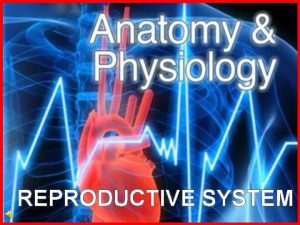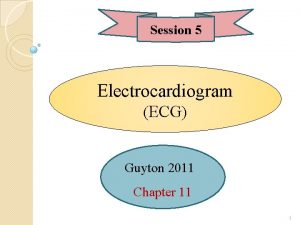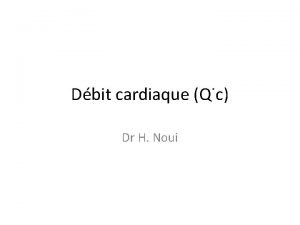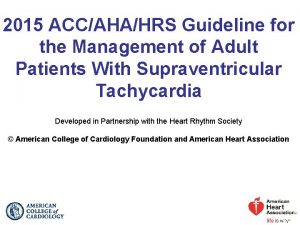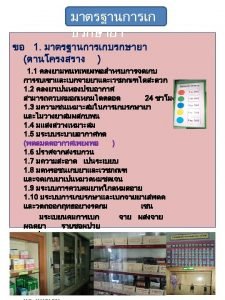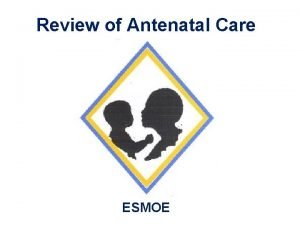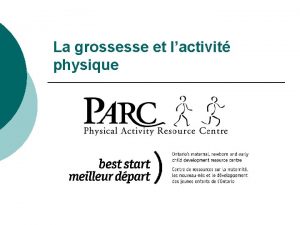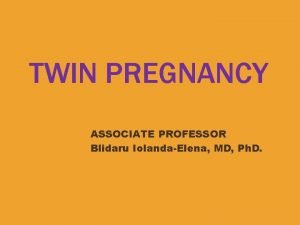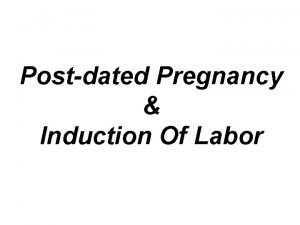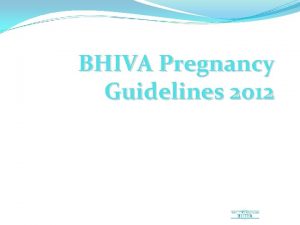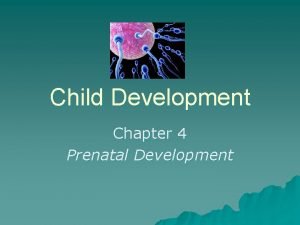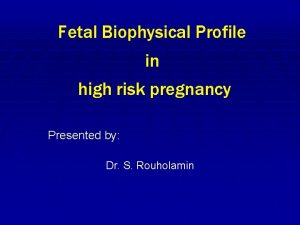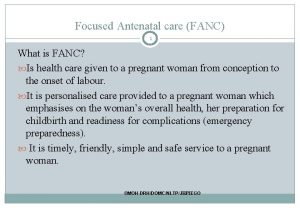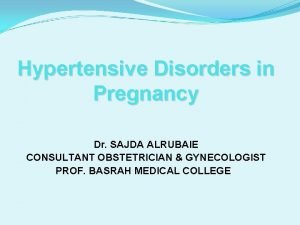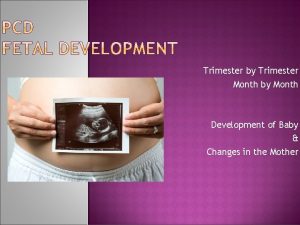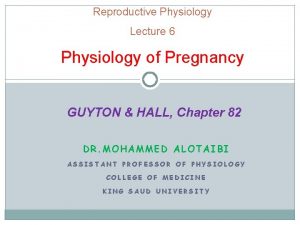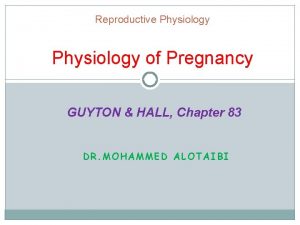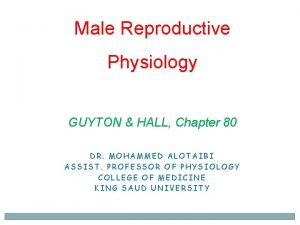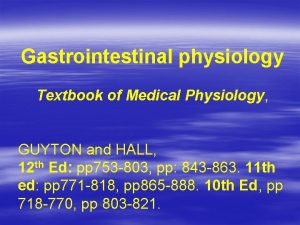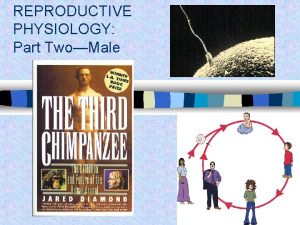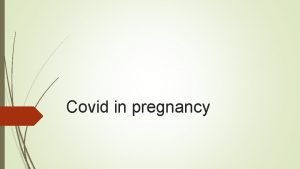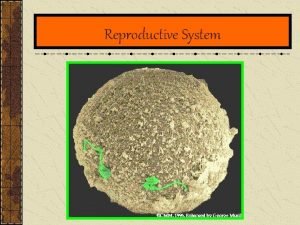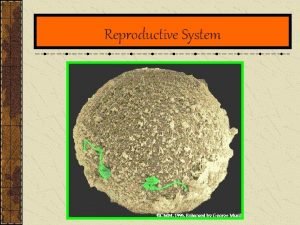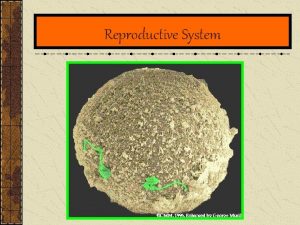Reproductive Physiology Lecture 6 Physiology of Pregnancy GUYTON







































- Slides: 39

Reproductive Physiology Lecture 6 Physiology of Pregnancy GUYTON & HALL, Chapter 82 DR. MOHAMMED ALOTAIBI ASSISTANT PROFESSOR OF PHYSIOLOGY COLLEGE OF MEDICINE KING SAUD UNIVERSITY

Objectives By the end of this lecture, you should be able to: �Describe fertilization and the implantation of the blastocyst in the uterus �Recognize the development and the normal physiology of the placenta �Describe the physiological functions of placental hormones during pregnancy �Explain the physiological response of mother’s body to pregnancy

Fertilization If the ovum becomes fertilized by a sperm, a new sequence of events called gestation or pregnancy takes place, and the fertilized ovum eventually develops into a full-term fetus.

Fertilization After ejaculation, sperms reach ampulla of fallopian tube within 30 -60 min (PG and OT actions)

Fertilization ZP 3 Receptor (zona pellucida glycoprotein 3)

Fertilization Ø Oocyte divides to form mature ovum (female pronucleus 23 unpaired chr. ) Ø Head of sperm swells (male pronucleus 23 unpaired chr) Ø Fertilized ovum (zygote) contains 23 paired chr. The 23 chr. of the male and female pronuclei align themselves to re-form a complete complement of 46 chromosomes

Zygote

Cleavage �Following fertilization, the zygote undergoes several mitotic divisions inside the zona pellucida (overall size does not change). � 1 st cleavage yields a 2 celled embryo each cell is called a blastomere and is totipotent �Divisions continue rapidly until the 32 cell stage (morula)

Traveling �Zygote begins to divide as it travels through oviduct. �Implants into lining of uterus (endometrium).

Transport of fertilized ovum Transport: fluid current + action of cilia + weak contractions of the fallopian tube Delayed transport allows cell division to occur before the dividing ovum (Blastocyst ~100 cells) enters the uterus 3 to 5 days Isthmus: Progesterone Ovary Uterine tube Secondary oocyte Ovulation Uterus Endometrium

Cleavage (a) Zygote (fertilized egg) Fertilization (a) Ovary Uterine tube Secondary oocyte Ovulation Uterus Endometrium

Cleavage (a) Zygote (fertilized egg) (b) Early cleavage 4 -cell stage Fertilization (a) (b) Ovary Uterine tube Secondary oocyte Ovulation Uterus Endometrium

Cleavage (a) Zygote (fertilized egg) (b) Early cleavage 4 -cell stage Fertilization (c) Morula (a) (b) (c) Ovary Uterine tube Secondary oocyte Ovulation Uterus Endometrium

Cleavage Blastocyst cavity (a) Zygote (fertilized egg) (b) Early cleavage 4 -cell stage Fertilization (c) Morula (d) Early blastocyst (a) (b) (c) Ovary (d) Uterine tube Secondary oocyte Ovulation Uterus Endometrium

Cleavage Inner cell mass Blastocyst cavity Trophoblast (a) Zygote (fertilized egg) (b) Early cleavage 4 -cell stage (c) Morula (d) Early blastocyst (b) Fertilization (a) (e) Late blastocyst (implanting) (c) Ovary (d) Uterine tube (e) Secondary oocyte Ovulation Uterus Endometrium

Implantation � Implantation occurs on 5 -7 day after ovulation. �Trophoblastic cords from blastocyst. �Blood capillaries grow in the cords. � 21 days after fertilization, blood starts to be pumped by fetal heart into the capillaries. �Maternal blood sinuses develop around the trophoblastic cords.

Implantation Blood sinuses supplied with blood from the mother develop around the outsides of the trophoblastic cords. While the trophoblastic cords from the blastocyst are attaching to the uterus, blood capillaries grow into the cords from the vascular system of the newly forming embryo. More and more trophoblast projections develop (placental villi)

Function of the Placenta Major functions �Respiration �Nutrition �Excretion �Endocrine �Protection

Placental permeability and membrane diffusion conductance In the early months of pregnancy, the placental membrane is still thick because it is not fully developed. The surface area is small because the placenta has not grown. In later pregnancy, the permeability increases because of thinning of the membrane diffusion layers and because the surface area expands many times over.

Important factors facilitating delivery of oxygen to the fetal tissues Diffusion of oxygen through the placental membrane � The mean partial pressure of oxygen (PO 2) of the mother’s blood in the placental sinuses is about 50 mm Hg, and the mean PO 2 in the fetal blood after it becomes oxygenated in the placenta is about 30 mm Hg. 50 mm Hg – 30 mm Hg = 20 mm Hg (mean pressure gradient) � There are three reasons why this low PO 2 is sufficient to deliver O 2 to the fetal tissues: 1. Hemoglobin of the fetus 2. Fetal hemoglobin concentration 3. The Bohr effect

Important factors facilitating delivery of oxygen to the fetal tissues Hemoglobin of the fetus Fetal hemoglobin (Hb. F) The fetal hemoglobin concentration is about 50% greater than that of the mother At the low PO 2 levels in fetal blood, the fetal hemoglobin carry 20 to 50% more oxygen than maternal hemoglobin can. . Oxygen-hemoglobin dissociation curves

Important factors facilitating delivery of oxygen to the fetal tissues � Double Bohr Effect � High p. H in fetal blood (alkaline). Low p. H in mother’s blood (acidic) These changes cause the capacity of fetal blood to combine with O 2 to increase, and maternal blood to O 2 decrease, which forces more O 2 from the maternal blood while enhancing oxygen uptake by the fetal blood. alkaline CO 2 PCO 2 2 -3 mm Hg higher in fetus acidic

Diffusion of foodstuffs through the placental membrane �Fetus uses mainly glucose for nutrition so the trophoblast cells in placental villi transport glucose by carrier molecules; GLUT (facilitated diffusion) �Fatty acids diffuse due to high solubility in cell membrane (more slowly than glucose) �The placenta actively transports all amino acids, with fetal concentrations exceeding maternal levels. �K+, Na+ and Cl- diffuse from maternal to fetal blood

Excretion �Excretory products of the fetus diffuse through the placental membrane to maternal blood to be excreted with the waste products of the mother Urea, uric acid and creatinine �Higher conc. of excretory products in fetal blood ensures continuous diffusion of these substances to the maternal blood

Placenta as an Endocrine Organ

Sources of placental estrogen and progesterone 3β-HSD DHEA Aromatase 3β-Hydroxysteroid dehydrogenase (3β-HSD)

Placenta as Endocrine Organ �Estrogen Steroid hormone Secreted by syncytial trophoblast cells Towards the end of pregnancy it reaches 30× Derived from weak androgen (DHEA) released from maternal & fetal adrenals cortex �Functions in the mother Enlargement of uterus, breast & external genitalia Relaxation of pelvic ligaments in preparation for labor Activation of the uterus (gap junctions)

Placenta as Endocrine Organ �Progsterone Steroid hormone Secreted by syncytial trophoblast cells Towards the end of pregnancy it reaches 10× Derived from cholesterol �Functions in the mother Provides nutrition to developing embryo (uterine secretory phase) Development of decidual cells Inhibits the contractility of the uterus

h. CG level (pregnancy test)

Placenta as an Endocrine Organ �Human Chorionic Gonadotropin (h. CG) Glycoprotein Secreted by syncytial trophoblast cells Most important function is to maintain corpus luteum (↑estrogen & progesterone) till 13 -17 weeks of gestation Exerts interstitial (Leyding) cell-stimulating effect on testes of the male fetus (growth of male sex organs)

Placenta as an Endocrine Organ �Human Chorionic Somatomamotropin or Human placental lactogen (h. PL) Protein hormone Secreted by placenta around 5 th gestational week �Functions in the mother Breast development Weak growth hormone’s action Inhibits insulin sensitivity =↓ glucose utilization Promotes release of fatty acids

Placenta as an Endocrine Organ �Relaxin Polypeptide Secreted by corpus luteum and placenta �Functions in the mother Relaxation of symphysis pubic ligament (weak) Softens the cervix at delivery

Physiological adaptation to pregnancy

Changes in maternal endocrine systems �Anterior pituitary gland enlargement (50%) Release of ACTH, TSH and PL FSH and LH almost totally suppressed �Adrenal gland Increase glucocorticoids secretion (mobilize AA) Increase aldosterone (retain fluid) �Thyroid gland enlargement (50%) Increase thyroxine production (h. CG) �Parathyroid gland enlargement Increase PTH secretion (maintains normal Ca 2+)

Changes in different organs �Increase in uterine size (50 gm to 1100 gm) �The breasts double in size �The vagina enlarges �Development of edema and acne �Masculine or acromegalic features �Weight gain 10 -12 kg (last 2 trimesters) Increase appetite � Removal of food by fetus � Hormonal effect

Metabolism and kidney function during pregnancy �Increase basal metabolic rate (15%). �Increase in daily requirements for: Iron Phosphates Calcium Vitamins - vitamin D (Ca 2+ absorption) �The renal tubules’ reabsorptive capacity for Na, Cl, and water is increased as much as 50%. �The renal blood flow and GFR increase up to 50%. �Normal pregnant woman accumulates only about 5 pounds (2. 27 Kg) of extra water and salt.

Changes in circulatory system �Increase in cardiac output (30 -40%) by 27 th weeks. �Increase in blood flow through the placenta. �Increase in maternal blood volume (30%) due to: Increase aldosterone and estrogen (↑ ECF) Increase activity of the bone marrow (↑ RBCs)

Changes in respiration �Increase in O 2 consumption (20%): Increase BMR Increase in body size �Increase in respiratory rate (RR). � Progesterone ↑ sensitivity of respiratory centre to CO 2. �Increase in minute ventilation by 50% and a decrease in arterial PCo 2 to several millimeters.

The End Thank You
 Rbc formation stages
Rbc formation stages Animal physiology guyton
Animal physiology guyton Definition of spotting during pregnancy
Definition of spotting during pregnancy Epilization
Epilization Chapter 13 anatomy and physiology of pregnancy
Chapter 13 anatomy and physiology of pregnancy Electrocardiogram
Electrocardiogram Précharge et postcharge def
Précharge et postcharge def Guyton
Guyton Raas system
Raas systemErythropoiesis guyton
 Luteinizing hormone in male reproductive system
Luteinizing hormone in male reproductive system Chapter 2 human reproductive anatomy and physiology
Chapter 2 human reproductive anatomy and physiology Microbial physiology lecture notes
Microbial physiology lecture notes 01:640:244 lecture notes - lecture 15: plat, idah, farad
01:640:244 lecture notes - lecture 15: plat, idah, farad Svt pregnancy
Svt pregnancy Lchad deficiency
Lchad deficiency Mole pregnancy
Mole pregnancy Sulperazone obat apa
Sulperazone obat apa Antenatal card pdf
Antenatal card pdf 1 week darkening areola early pregnancy pictures
1 week darkening areola early pregnancy pictures Height of fundus during pregnancy
Height of fundus during pregnancy Position couchée grossesse
Position couchée grossesse Molar pregnancy differential diagnosis
Molar pregnancy differential diagnosis Trimester graphic organizer
Trimester graphic organizer Anemia pregnancy
Anemia pregnancy Modified bishop score rcog
Modified bishop score rcog Bhiva guidelines pregnancy
Bhiva guidelines pregnancy Lightening pregnancy
Lightening pregnancy Insulin dose calculation in pregnancy
Insulin dose calculation in pregnancy Way to prevent teenage pregnancy
Way to prevent teenage pregnancy Can early pregnancy feel like period cramps
Can early pregnancy feel like period cramps Biophysical profile score
Biophysical profile score Pregnancy test keeps saying error
Pregnancy test keeps saying error Fanc
Fanc Vermont sheep and goat
Vermont sheep and goat Sajda during pregnancy
Sajda during pregnancy Coker definition
Coker definition Lack of knowledge in teenage pregnancy
Lack of knowledge in teenage pregnancy Episiotomy structures cut
Episiotomy structures cut Trimester graphic organizer
Trimester graphic organizer



